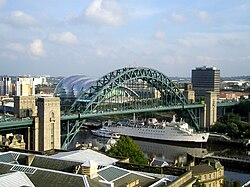Tyne Bridge | |
|---|---|
 Tyne Bridge looking towards The Glasshouse, Gateshead with the since-scrapped Tuxedo Princess moored below. The banner is advertising the 2006 Great North Run | |
| Coordinates | 54°58′05″N 1°36′22″W / 54.9680°N 1.6060°W |
| OS grid reference | NZ253637 |
| Carries | |
| Crosses | River Tyne |
| Locale | Tyneside |
| Other name(s) | New Tyne Bridge[1] |
| Owner | |
| Maintained by | Newcastle–Gateshead Bridges Joint Committee |
| Preceded by | Swing Bridge |
| Followed by | Gateshead Millennium Bridge |
| Characteristics | |
| Design | Through arch bridge |
| Material | Steel |
| Pier construction | Cornish granite |
| Total length | 389 m (1,276 ft) |
| Width | 17 m (56 ft) |
| Longest span | 161.8 m (531 ft) |
| Clearance below | 26 m (85 ft) |
| No. of lanes | 4 |
| History | |
| Designer | Mott, Hay and Anderson |
| Constructed by | Dorman Long and Co. |
| Construction start | August 1925 |
| Construction end | 25 February 1928 |
| Opened | 10 October 1928 |
| Inaugurated | 10 October 1928 by King George V |
| Statistics | |
| Daily traffic | approx. 70,000 vehicles |
| Type | Grade II* listed building |
| Designated | 13 January 1983[1] |
| Reference no. | 1248569 |
| Location | |
 | |
The Tyne Bridge is a through arch bridge over the River Tyne in North East England, linking Newcastle upon Tyne and Gateshead. The bridge was designed by the engineering firm Mott, Hay and Anderson,[2] who later designed the Forth Road Bridge, and was built by Dorman Long and Co. of Middlesbrough.[3] The bridge was officially opened on 10 October 1928 by King George V and has since become a defining symbol of Tyneside. It is ranked as the tenth tallest structure in Newcastle.
- ^ a b Cite error: The named reference
nhlewas invoked but never defined (see the help page). - ^ Elwall, Robert. "Tyne Bridge". British Architectural Library. Retrieved 14 July 2014.
- ^ "Dorman Long Historical Information". dormanlongtechnology.com. Retrieved 14 July 2014.